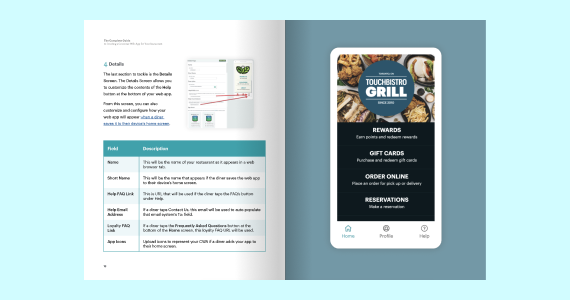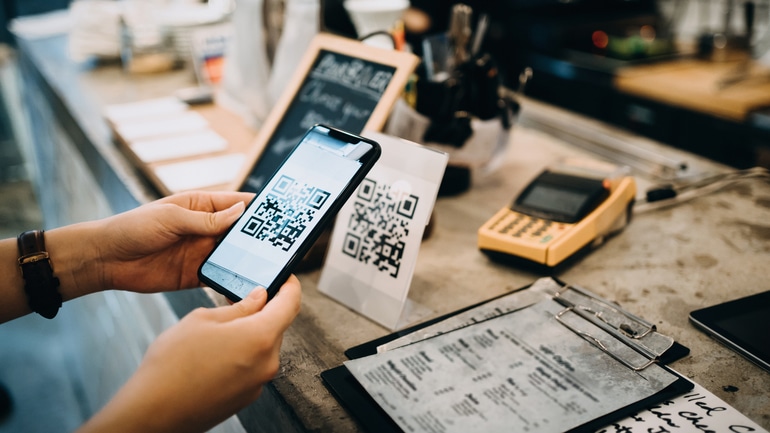These days, having a great restaurant app is just as important as having a great menu and atmosphere.
In 2019, research by BRP Consulting found that 38% of dining experiences now involve smartphones or mobile devices. And this number only increased during the COVID-19 pandemic – especially for those restaurant brands with a mobile loyalty program.
While the pandemic may have kicked app usage into overdrive, there’s no question that a great restaurant app offers many benefits for both your guests and your business. While your customers enjoy the convenience of having everything they need in one place, your restaurant enjoys greater access to diner insights and a long-term boost in sales – it’s win-win.
Of course, not all restaurant apps are created equal. In recent years, progressive web apps have become a popular alternative to mobile apps for restaurants that need a quick and easy app solution. Unlike a mobile app, a progressive web app runs in a browser, which means customers can access it from their phone, tablet, or any other device (without the need to download anything).
Big brands like Starbucks are already reaping the benefits of progressive web apps. In fact, the brand saw two times more daily and monthly active users after the launch of the Starbucks progressive web app.
To help you understand the benefits of a progressive web app for your own business, this article will cover everything you need to know about implementing this new type of restaurant app, including:
- What is a progressive web app and how it differs from a native mobile app
- The 6 benefits of using a web-based app in your restaurant
- How to create your own custom-branded customer web app
- How to promote your web app to guests

Download our illustrated guide to setting up and customizing your TouchBistro Customer Web App.
Progressive Web Apps vs Native Mobile Apps
Before exploring the benefits of a progressive web app for your restaurant, it’s important to understand how a web app differs from a native mobile app.
Progressive Web Apps
So what is a progressive web app? The simplest way to understand progressive web apps is that they’re a website with all the benefits of an app. A progressive web app can be accessed from a browser like Chrome or Safari just like any other website, which means there’s no download involved. But unlike a regular website, progressive web apps come with added benefits like offline usability, in-app messages, and access to your devices’ hardware – things that were previously only available to native mobile apps.
A more technical explanation of progressive web apps is that they are built using web-based coding languages such as HTML, CSS, and JavaScript, so they can run in a web browser. This makes progressive web apps faster and less expensive to build.
Of course, you don’t necessarily need to go through the process of building a web app yourself. For instance, if you use TouchBistro Loyalty, you can set up your very own progressive web app, called a Customer Web App (CWA), in just minutes – no coding or technical knowledge required.
Native Mobile Apps
On the other hand, native apps are specifically designed to run on mobile devices, not web browsers. This means a native app needs to be downloaded from Apple’s App Store or Google’s Play Store because it has been built in a programming language specific to that platform, such as Swift or Java.
Therefore, if you want to build a native app that works on both Apple and Android devices, you need to know different programming languages – there’s no easy way to build one app and publish it to all the app stores out there. As a result, native apps are much more expensive to build, and require more resources to maintain and update each version of the app. In fact, a native app built from scratch can cost between $50,000 to $100,000 to get the first versions out on iOS and Android, and then another 20% of that cost annually for maintenance and updates.
Not to mention, native apps can be less user-friendly because users need to download the apps from app stores in order to use them – an extra step that can discourage people from using an app in the first place.

6 Benefits of Using a Web-Based Restaurant App
It’s clear that progressive web apps have some big advantages over native mobile apps from a technical perspective. Now let’s explore some of the tangible benefits of using a progressive web app like TouchBistro’s CWA in your venue.
1. Better Customer Experience
Perhaps the biggest benefit of using a progressive web app is that it offers a better user experience for your customers than a native mobile app.
Consider this: the average smartphone user installs zero mobile apps in a month. This is largely because downloading a native mobile app requires going through the tedious process of visiting an app store, downloading an app, waiting for the installation to finish, and then granting the app permissions – that’s a lot of steps! Not to mention all the storage space that a native app then takes up on a device.
However, if your restaurant uses a web-based app, this lengthy process is eliminated entirely. As mentioned already, customers can access a web app directly from a web browser like Chrome or Safari, so they don’t need to go through the tiresome rigamarole of downloading and installing anything on their personal device. Instead, a web app can be accessed by simply typing in a URL or even scanning a QR code. Guests can even save a progressive web app to their device’s home screen and access it just like any other native app.
Web apps are also a lot lighter and more accessible than native apps, meaning they don’t take up any space on a user’s device. This translates to a much faster and smoother user experience within the app, which can be a big plus for diners who value speed and convenience. In fact, web apps can even be in poor network conditions, which is great if your restaurant suffers from spotty WiFi.
2. Everything Your Customers Need, All in One Place
Part of this better customer experience is that your guests can access everything they need in one convenient place. Instead of using multiple different platforms, customers can access virtually all of your restaurant’s offerings directly from your web app. This means that whether they want to purchase a digital gift card, access your restaurant loyalty program, find your reservations platform, or browse your online menu, all that and more can be done directly through your web app, at any time (even outside of your venue).
And even though there’s no download required, a web app can still be saved to the home screen of a device for quick and easy access. For instance, if your restaurant uses a custom-branded Customer Web App like TouchBistro’s, users will be prompted to “save” the app to their home screen after signing in. This process is as simple as diners tapping the “add to home screen button” on their phone. After that, diners can easily access your restaurant’s app directly from the home screen of their phone anytime, just like any other native app.
This is a feature that’s already proven popular with other web apps. For instance, just six months after the launch of the Starbucks progressive web app, the brand reported 800,000 people per week interacting with the web app from the home screen of their device, just like the brand’s native app.

Download our illustrated guide to setting up and customizing your TouchBistro Customer Web App.
3. Seamless Communication With Customers
One of the big benefits of a web app is that you can use in-app messaging to communicate directly with your customers. An in-app message is a message that appears to users directly in your progressive web app. These kinds of notifications can be sent at any time, and the user doesn’t have to be in the app or even using their device to receive them.
In short, in-app messaging provides a direct line of communication with your customers. And with foot traffic still down in many places due to the COVID-19 pandemic, in-app messages are a perfect way to re-engage your app users while they’re at home. Whether you want to promote a limited-time offer or a brand-new menu item, in-app messages allow you to speak directly to customers and to remind them why they should pay your restaurant a visit.
In-app messages are also an extremely effective form of marketing. Unlike emails, in-app messages don’t get caught in spam filters or forgotten in a user’s inbox. And unlike push notifications, users don’t have to explicitly opt-in to receive in-app messages. Not to mention, studies have found that in-app messaging can lead to a 30% increase in app launches and a whopping 4x increase in app retention.
4. Learn More About Your Guests
Another big benefit to any restaurant app is access to valuable diner data.
When guests use your app to take part in restaurant loyalty programs, you can collect details like name, email address, birthday, visit history, spend, items purchased, and more. This is because when guests use the customer web app (CWA) to make purchases, their transaction data flows directly into the CRM platform. If you also have a marketing platform like TouchBistro Marketing, you can then use this data to send custom promotions to your guests via email or in-app message. For example, you can use this information to deliver personalized, VIP experiences that delight guests and boost sales.
Plus, with an integrated marketing solution like TouchBistro Marketing, you can prompt guests to leave their feedback directly in the CWA. This allows you to collect even more valuable insights about your customers’ experience, so you can then adjust your business accordingly.
Loyalty transactions, like what customers are buying and how much they’re spending, flow directly into the CRM platform. The CWA simply lets customers check into their loyalty accounts, which then ensures their transaction data is sent to the CRM platform.
5. Increase Staff Productivity
Progressive web apps have the added benefit of helping to boost staff productivity in your restaurant because they require staff to spend less time assisting in each guest’s customer journey.
As mentioned, a web app can be accessed quickly and easily from a web browser. This means that if staff is helping a customer sign up for your restaurant reward program, the process is much faster than if a customer needs to go through the lengthy process of downloading a mobile app from an app store. This not only keeps lines moving, but it also allows staff to spend less time helping customers set up mobile apps, and more time on other tasks.
Progressive web apps can also save staff time when it comes to helping customers earn and redeem rewards. For instance, with TouchBistro’s CWA, diners can collect and redeem rewards with a quick scan of a QR code, so there’s no need for staff to manually input any information into the POS.
6. Boost Sales
Perhaps the biggest benefit of using a progressive web app in your restaurant is the inevitable boost in sales.
Though progressive web apps are still relatively new, many businesses have already seen an increase in sales after introducing this technology. For example, the beauty brand Lancôme saw a 16% year-over-year increase in sales after rolling out its own progressive web app. The brand attributes this success to faster load times, a better user experience, and targeted push notifications.

How to Create a Customer Web App for Your Restaurant
Based on all the benefits outlined above, you’re probably wondering how to create a progressive web app for your own restaurant.
As mentioned already, progressive web apps are much faster and cheaper to build than native mobile apps. However, building a web app does still require the skills of a developer, which not everyone has. Even if you use a progressive web app builder, creating a high-quality app can be tricky, which is why the best solution for most restaurateurs is to use a ready-made solution like TouchBistro’s CWA.
TouchBistro’s CWA is a fully customizable web app solution available to all TouchBistro Loyalty and TouchBistro Digital Gift Card customers. When you begin using TouchBistro’s CWA in your venue, you have the ability to add your own logo, colors, and branding to the app to ensure it integrates seamlessly with your own marketing materials and decor. You can then set up and deploy your CWA directly from the Guest Engagement section in Cloud, with no need to contact the TouchBistro support team.
After the initial setup process is complete, managing your CWA can be done easily and independently, with all operations centralized within Cloud. And if you use TouchBistro Marketing, you can easily update your app with the latest offers, create tailored promotions, and communicate directly with your app users through email or in-app messaging.

Download our illustrated guide to setting up and customizing your TouchBistro Customer Web App.
How to Promote Your Customer Web App to Guests
Once you’ve got your web app up and running, the final step is making sure customers know about it and remember to use it. Here are six easy tips for promoting your web-based restaurant app:
- In-Store Signage: Promote your web app via in-venue signage, table tents, check presenters, on printed checks, and more. You can even include a QR code on any signs so customers can access your web app immediately without typing in the URL.
- Your Restaurant Website: A web app can be accessed in a browser so you can link to your app directly from your restaurant’s website. Just take the example of Mew’s Tavern, which has created a dedicated App + Loyalty section on its website to promote its own web app.
- Social Media Profiles: Add a link to your web app in your social media bios and create dedicated posts explaining exactly how customers can use your app to engage with your restaurant.
- Email Marketing: If you have an existing list of customer emails, send a dedicated email promoting your new web app and explaining how customers can access it.
- Staff: Your staff are your best brand ambassadors. Be sure to train staff to tell customers that you offer a web app and to highlight all the benefits of using it.
- Offer an Incentive: Every customer loves a good promotion, so consider offering a one-time discount to anyone who signs up for your web app.
In the wake of the COVID-19 pandemic, implementing a progressive web app like TouchBistro’s CWA is one of the best (and easiest ways) to elevate the customer experience and make the most out of your restaurant management system. Unlike a native mobile app, a web-based restaurant app offers customers a fast, accessible, and convenient way to enjoy everything your restaurant has to offer – all in one place. And at the end of the day, a better customer experience for your guests translates into healthier profits for your restaurant.

Download our illustrated guide to setting up and customizing your TouchBistro Customer Web App.
Free Restaurant Cleaning Checklist
Sign up for our free weekly TouchBistro Newsletter







